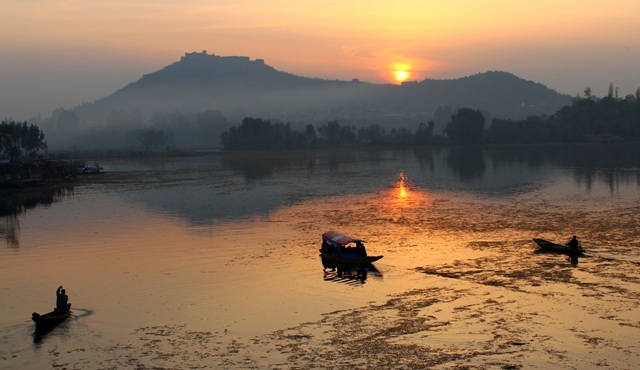Srinagar: The natural beauty of the Kashmir Valley is an overpowering sight after traversing the 2.5-km bleakly-lit Jawahar Tunnel. Cradled in the midst of towering mountains, Kashmir is a rich canvas of all shades of green, with wild flowers sprinkled liberally everywhere.
All along the way to Srinagar, the roadside is a riot of colours with even the smallest households having a beautiful garden, with roses and pansies in full bloom.
The natural beauty of the land comes as a great contrast to the bunkers of the Central Reserve Police Force (CRPF), fortified with sandbags, manned by gunmen and surrounded by rolls of razor wire.
Once inside Srinagar, the state capital, the presence of security personnel increases substantially, with bunkers and riot control vehicles on almost every street and crossing.
“Some sort of unrest happens here almost every day but you don’t have to worry. You are from outside and they don’t hurt tourists,” says a CRPF soldier.
The Kashmiri point of view differs.
“Nowadays we don’t have any problems. The forces man the city and there are no untoward incidents any more,” said Jemal, a waiter at a hotel in Srinagar’s Lal Chowk.
“But now they don’t need to be here in such large numbers. The tourists get scared,” he adds, after a moment of thought.
However, Lal Chowk still bears the scars from several decades of unrest. A bombed out cinema hall turned into CRPF bunker, a CRPF post blackened with fire, the bullet marks on the area’s namesake red-coloured Sanatan Dharma building, which once served as a charity guesthouse for Amarnath pilgrims.
Due to the peace, the tourists have returned to the Valley in huge numbers this year.
Inside Srinagar, the traveller can catch a whiff of mutton and Kashmiri spices being cooked over a coal fire in every street. The Seekh kebabs with a rumali roti are cheap but tasty. For dessert, there are stalls of phirni, sewaiyon ki kheer and kulfi after a day of tasting street-food.
“In Kashmir, you should go for a wazwan if you can. It is a completely different experience. Essentially, the Kashmiri term for ‘feast’, wazwan is also the best showcase of Kashmiri cuisine,” Raja Muneeb, a hotelier, told IANS.
The traditional wazwan is a wedding feast spread over more than 10 courses, ranging from appetizers to dessert.
Then there are the usual attraction of Kashmiri shawls, dry fruits and saffron.
Shop after shop in the local Kukar Bazaar selling saffron, almonds, apricots, walnuts, pre-mixed Kahwa powder and bundles of cinnamon is a huge draw with the tourists looking for the best Kashmiri produce.
Apart from Srinagar, Gulmarg remains one of the biggest draws for tourists. Rolling green grassy mountainsides give way to tall Deodars on the upper reaches, before finally making way for the snow-capped tips. The fact that the place has also been the setting for shooting of many Hindi films also helps lure the tourist.
Home to a mountaineering institute and a golf course, Gulmarg also has the world’s highest Gondola cable car. The more adventurous ones can trek through the virgin forest of Deodar and pine, with rashes of sweet smelling wild roses and lush meadows.
The valley comes out as a land of duality. It is as if the war zone-like security and the paradise on earth have somehow learnt how to co-exist.
The Kashmiri, however, claims that everything is fine and ends the conversation. Quick to laugh or joke, the Kashmiri on the street doesn’t seem to be a violent person. But after long years of hearing about the “Kashmir problem”, the distrust is mutual.
The huge military presence also adds to the Kashmiri’s insecurity. Perhaps we need to bridge his distrust rather than soldier his thoughts.
Photo: Ifran Hashim
IANS
The opinions, beliefs and viewpoints expressed by authors, news service providers on this page do not necessarily reflect the opinions, beliefs and viewpoints of Hill Post. Any views or opinions are not intended to malign any religion, ethnic group, club, organization, company, or individual.
Hill Post makes no representations as to the accuracy or completeness of any information on this site page.



